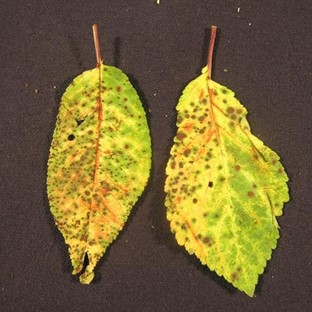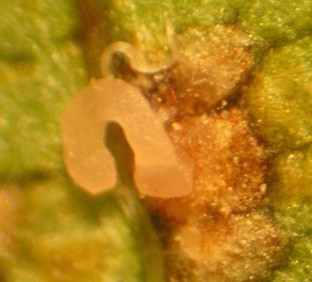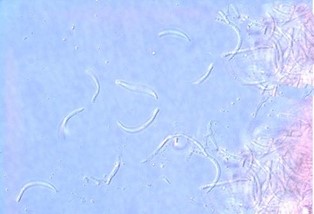Disease Notes
Contact
Plant Diagnostician
Phone: (479) 575-2727
Email: ssmith@uada.edu
Jason Pavel
Diagnostician
Phone: (479) 575-7257
Email: jpavel@uada.edu
University of Arkansas System Division of Agriculture
Cralley Warren Building
Room 16
2601 N. Young Ave.
Fayetteville, AR 72704
Cherry Leaf Spot
by Sherrie Smith and Jason Pavel

Cherry Leaf Spot – Blumeriella jaapii
Photo by Sherrie Smith University of Arkansas Cooperative Extension
Cherry Leaf Spot (Shothole), caused by Blumeriella jaapii, (formerly known as Coccomyces hiemalis) anamorph Phloeosporella padi, is the most important fungal disease of cherry wherever cherries are grown. Plums are susceptible as well.

Cherry Leaf Spot Spore mass – Blumeriella jaapii
Photo by Sherrie Smith University of Arkansas Cooperative Extension
How can you identify Cherry Leaf Spot?
Symptoms begin as small reddish to purple circular spots on the leaves. On the underside of the leaves, extruded masses of white to pink spores are produced during wet conditions. The leaves take on a mottled appearance as the tissue becomes yellow, leaving the area around the lesions green. On plums, the necrotic lesions may drop out, giving a shot-hole appearance. The infected leaves fall prematurely, reducing fruit yields and weakening the tree. In severe cases, complete defoliation may occur. Early defoliation may reduce bud survival and fruit set for at least two seasons.
How do you control Cherry Leaf Spot?
The fungus overwinters in fallen leaves on the ground that were infected the previous season. Therefore, sanitation is important in controlling Cherry leaf spot. Clean up all fallen leaves. Fungicides should be applied at petal fall and at 7–10-day intervals to harvest. Commercial growers may use a copper fungicide, Gem, or Pristine. Homeowners may use Captan or a copper fungicide.

Cherry Leaf Spot Spores – Blumeriella jaapii
Photo by Sherrie Smith University of Arkansas Cooperative Extension
Take Aways
- Clean up all fallen leaves.
- Apply fungicides at petal fall, continuing at 7 to 10-day intervals until harvest.
This work is supported by the Crop Protection and Pest Management Program [grant no. 2017-70006- 27279/project accession no. 1013890] from the USDA National Institute of Food and Agriculture.